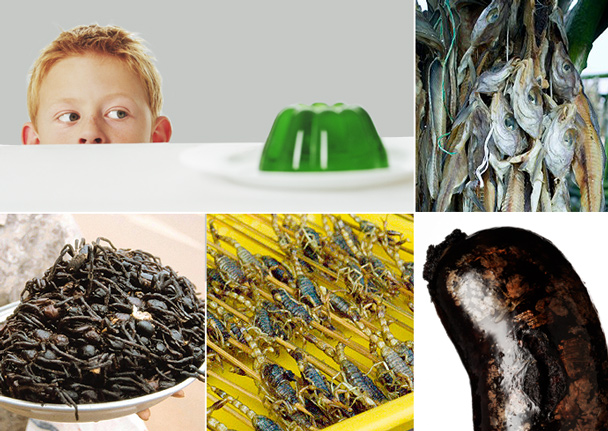This story originally appeared on Concierge.com, part of the Condé Nast Traveler network of travel sites.
Welcome to our international culinary chamber of horrors, where succulent spiders, gleaming sheep guts, and deadly seafood await your delectation. (Cue evil laugh and lightning bolt.)
Our global tour of freaky foods is all in good fun, if not in good taste. Just as one man's trash is another man's treasure, one culture's treasured culinary delicacy (or survival staple) is another culture's "eeew"—and perhaps no food culture is more guilty of culinary shock and awe than our own. After all, the United States food industry is responsible for Cheez Whiz, Jell-O, Cool Whip, and a parade of rampaging pathogens year after year, so who are we to be grossed out by barbecued bat?
Nevertheless, some of the creepy, icky foods in our gallery of ghoulish goodies are guaranteed to make you wonder "Who could possibly eat that?" Put away your lunch; take a deep breath; and read on, if you dare.
Barbecued Bat
What it is: Popular Halloween symbol transformed into crunchy grilled goodnessWhere it's served: Indonesia, Thailand, and Vietnam
Want a bite? Bats are particularly plentiful in the limestone caves of Asia and the Pacific, and bat stew or barbecued bat are easy to find at restaurants and street carts in the region. Typically, the fur is singed off and the wings and head removed first (not much meat there); then, depending on the size of the bat, the body can be diced into bite-size chunks for a stew or stir-fry. Smaller bats are better suited to the popular street-meat preparation of seasoning, grilling, and eating whole—crunchy little bones and all. Even bat fans admit that the delicacy doesn't smell so hot: Aside from the aroma of singed fur, bat meat itself gives off a strong, gamy odor as it's cooked, which the chef can usually mask (in part) with plenty of garlic and chile. Mmm, leathery.
Black Pudding
What it is: Pig or cow blood cooked with a bit of fat until it congealsWhere it's served: Britain, Ireland, France, and Germany
Want a bite? Bloodthirsty Britons gobble blood sausage as part of a traditional breakfast, usually along with beans, mushrooms, bread, and perhaps a tomato or a fried egg—you know, for nutrients or whatever. It's known in Germany as Blutwürst and in France as boudin noir, but whatever you call it, it's basically congealed blood in a sausage casing—which, just to remind you, is itself usually an intestine. Fans say it tastes just like a regular sausage, except…well, you know when you floss too hard and you get that blood-and-iron taste in your mouth? Yeah, those are basically the "flavor notes."
Baked Guinea Pig
What it is: Your childhood pet, now in snack formatWhere it's served: Peru and Ecuador
Want a bite? Cuy, as the dish is known, is actually a traditional and much-loved delicacy with a long history in Peruvian food culture…much the same way that cuddly little guinea pigs are a traditional and much-loved childhood companion with a long history in American pet stores. Cuy is special-occasion meat, generally served baked or grilled, and since guinea pigs are so tiny and chubby, typically a serving size is one pig per plate. We're told that the grass-fed, tender, delicious meat is reminiscent of rabbit, but we're too busy weeping softly over our memories of Mr. Fuzzbomb to care.
Jell-O
What it is: Cool, fruity animal hoovesWhere it's served: Bill Cosby's house, the Golden Corral
Want a bite? Jell-O is, of course, just one of many flavored-gelatin dessert brands, but the process of making gelatin is fairly consistent: Simply grind up the bones, ligaments, and hooves of cows and pigs; pour acid on the results; and boil. (A similar process actually figures prominently in a chapter of Bret Easton Ellis' American Psycho.) Scrape off what floats to the top, and add a little sugar, water, and artificial flavors and colors. Pour it into a mold and allow it to solidify in the fridge, and you've got yourself a sweet treat with absolutely no relationship to anything you could reasonably describe as "food."



 Pinterest
Pinterest


